Love is a burnin' thing
And it makes a fiery ring
Bound by wild desire
I fell into a ring of fire
- Johnny Cash

New Zealand sits in the western Pacific Ocean, at the southern end of the circum-Pacific Belt ... a.k.a. the Ring of Fire. The circum-Pacific Belt is a chain of ocean trenches, volcanic arcs, and volcanic belts that extends around all but the southern portion of the Pacific Ocean. It contains >75% of the world's volcanoes and experiences 90% of the world's earthquakes.

The Taupo Volcanic Zone has one of the greatest concentrations of geothermal activity in the world. Taupo and Rotorua were the destinations for our most recent outing ...
Mt Taranaki, where we were tramping a week ago, last erupted in the 1850's/1860's and the last major eruption was in 1655. At 350+ years since the most recent big one, it is considered "overdue" for another. Mt Ruapehu is at the southernmost end of the Taupo Volcanic Zone and started erupting 250,000 years ago. Minor eruptions are frequent, and major eruptions occur about every 50 years. The last major eruption was in 1995/96. Ruapehu is New Zealand's largest active volcano. In April 2016, the temperature of the crater lake was seen to rise from 25 C to 40 C with an increase in earthquake activity ("earthquake swarm"). It didn't erupt, but the signs are there.
Kari's brother Tony came to visit unexpectedly two weeks ago. We had already planned a trip to New Plymouth and dragged him along for some beach time and tramping. On his flight to New Zealand, he had read about the Champagne Pool at Waiotapu and it was the one thing he wanted to see. In true Highstead style, we overpacked our tiny little Suzuki Swift and headed out on the road for another weekend get-away.
Mt. Ruapehu has three major peaks: Tahurangi (2,797 m/9,177 ft), Te HeuHeu (2,755 m/9,039 ft), and Paretetaitonga (2,751 m/9,026 ft). Tahurangi is the highest point on the North Island and we weren't very far out of town before it became the dominant feature of the landscape. We were headed north of Mt Ruapehu into Taupo and had to skirt around to the East with the mountain on our left ... great for 100 km/hr views and pics out the passenger-side windows.


Chasing Ruapehu

Mt Ruapehu from the Desert Hwy
The initial plan was to head into Taupo, spend some time on the lake, have lunch, and maybe go to one of the hot-spring spas for a soak. Unfortunately, there was a triathlon going on, so getting in and around town was pretty much impossible. Instead, we made a brief stop at Huka Falls then headed north to Rotorua with plans to come back through Taupo on our way home.


As we continued to head north, the weather became more grey and drizzly. We made it to the Waiotapu gethoermal area, driving past the local spot for hot spring bathing, a natural pool where hot spring water mixes with a small stream resulting in a pool of tolerable temperatures. In Maori, Waiotapu means "Sacred waters".
The Maori used hot springs (waiariki) for cleaning and for cooking. On a prior visit to New Zealand, we had the opportunity to use a traditional Maori oven built over a steaming fissure. They also bathed in hot springs to treat skin conditions and rheumatic diseases. The bathing area at Waiotapu is for anyone to use, but the local iwi ask that visitors respect the traditions and history of the Maori. Unfortunately, the area is often populated by loud, nekkid bathers who leave behind beer bottles and cigarette butts. On the day we were there, the area was quiet. Bathers spoke in low tones and there was very little trash.

The Wai-O-Tapu Thermal Wonderland is a Maori held business run on the scenic reserve under a concession. Our plan was to tour the reserve but at $40 each, and on a dreary drizzly day, we decided to try again the next day during (hopefully) better weather. We did drive up to the mud pools to have a look. The mud pools sit on a site that was once a large mud volcano. Eventually destroyed by erosion, it is now a steaming and bubbling pit.
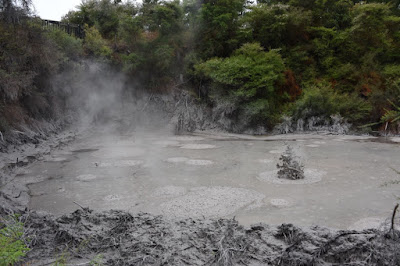
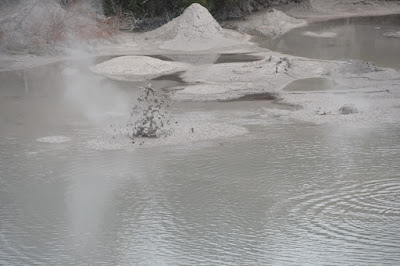
Waiotapu mud pools
Somewhere along the way, Rotorua was given the dubious nickname of "RotoVegas". Unlikely to have been called so for any positive reasons, it refers to the main drag lined on both sides by hotels and motels, and to the city's dependence on tourism. Nevertheless, some of the local businesses have adopted the name and tried to turn it into a positive thing. Our accommodations for the night were at the 1950-60's decor rotoVegas motel.

The "V" in Vegas is shaped like a geyser rising from a thermal pool
When you think of New Zealand, if you picture bungee jumping off bridges, strapping yourself into a giant swing across a gorge, jumping into a giant inflatable ball full of water and smashing down a hill, or any other crazy adrenaline-filled activity, then Rotorua is the place to go. It is also the centre of activity for tourist-driven Maori experiences. Be forewarned though, Rotorua is a geothermal town and the stink of hot sulfur is pervasive. Getting away from the city and up into the redwood forests and mountain lakes also removes you from the smell.


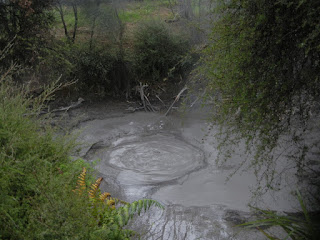
Kuirau Park
Ohinemutu Marae
The Maori first arrived in the land they called Aotearoa (New Zealand) some time between 1250-1300 CE. They traveled from Polynesia by canoe, bringing with them everything they thought they would need. This included food sources such as rats and dogs. In Aotearoa, they would have found a rugged, mountainous land alive with volcanic activity and covered in forests. Unforturnately, wherever man goes, so too go his pests and fire. By most estimates, pre-human New Zealand was 95% forest. By the time of European discovery, forest cover had been reduced by up to 30-40%, and it only accelerated after that. Europeans first arrived to New Zealand in 1772, and by 1840 less than 25% of New Zealand's native forests remained.
Drive anywhere on the North Island and you will see endless rolling fields of green grass providing ideal grazing habitat for sheep, cattle, and the occasional deer, goat or alpaca farm. It hides a sinister past. The land was clear cut and burned, and non-native grasses were introduced. Recognizing the irreversible changes to the environment wrought by such destruction, native forest logging on public land was halted in 2002. By 2010, forest cover had shown a modest improvement to approximately 31% of the total land area of New Zealand.
Rotorua Canopy Tours operates by concession in the Dansey Road Scenic Reserve, a 500 ha (1 hectare is approx size of a football field) section of native forest that has never been logged. Trees in the reserve can be over 1000 years old. While the flora has managed to remain somewhat pristine, the fauna has not fared so well.
Over the relatively short period of human occupation in New Zealand, multiple species have been introduced both inadvertently and intentionally. Introduced animals include 7 species of deer, feral hogs, hares & rabbits, stoats & ferrets, dogs, cats, goats, rats, and possum.
Animals in New Zealand evolved without any serious predators. Other than whales, dolphins, seals, and sea lions, the only native mammal is a bat. The only reptile native to New Zealand is the Tuatara. Destruction by the herbivores in the list of introduced species has been bad enough, but the meat eaters have absolutely devastated the native bird populations. Rats and other meat/egg eaters have driven many native species to extinction and some are hanging on only in isolated pockets. As part of their conservation effort, Rotorua Canopy Tours have taken on the task of clearing non-native animal species from 220 ha of the 500 ha reserve through trapping efforts and the eventual erection of exclusion fences. Once the pest species are eradicated, their ultimate goal is to re-introduce native species.
On our first trip to Rotorua, we spent a half day zip-lining through the forest with this awesome company. At that time, they were a little over a year old and our experience with this start-up was perfect. They were professional and safe, but still had that young seat-of-the-pants feel. Three years later, the company has grown substantially. Their operations are smooth and polished but manage to retain a cool, laid-back vibe. We are happy enough to spend our time and money with Rotorua Canopy Tours if only for the awesome job they do, but the tree-hugger in me is happy to know that part of the money I spend goes into ensuring this experience is sustainable.



Gearing up and safety briefing




Way far away and a way up high



These 3 photos courtesy of Rotorua Canopy Tours
After finishing our flight through the trees, we headed up through the redwood forest to see two adjacent lakes ... Blue Lake and Green Lake (which also looked blue). After a quick lunch, we were back on the road headed south to Waiotapu and the Champagne Pool which was the whole point of this trip to begin with. The entire walking tour of Wai-O-Tapu Thermal Wonderland takes 100-120 minutes, so we left that for Kari and Tony. Little Highstead and I went for a soak in the hotsprings.
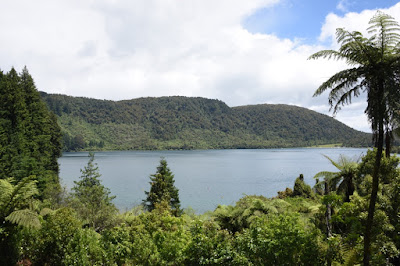
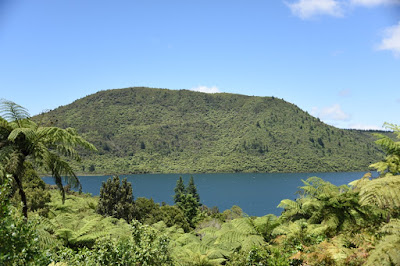
Blue Lake and Green Lake (no, I did not get them reversed)

Champagne Pool
As we flew down the motorway back to Palmy, we couldn't help but stop at Lake Taupo for sunset views of the lake, and to take one last photo of the movie-set backdrop that presents itself at seemingly every scenic overlook.
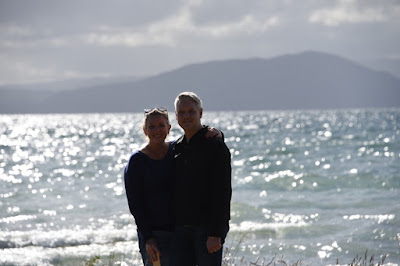




Y'all come back, now, ya' hear?
Next week, we are going to be traveling to the South Island on holiday. I will try to post something every day or two, but they won't be nearly as extensive or in depth as these last few posts ... more like a travelogue. Let me know if you like what I have done so far, or if you prefer the shorter more photo-intensive posts.


No comments:
Post a Comment